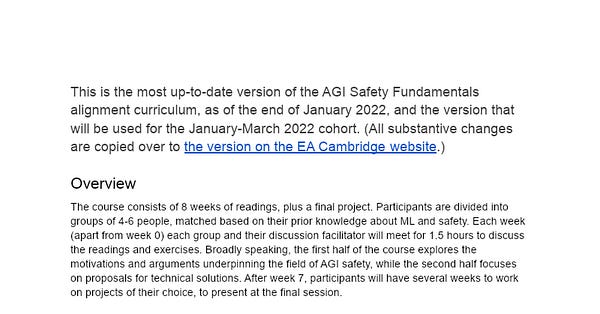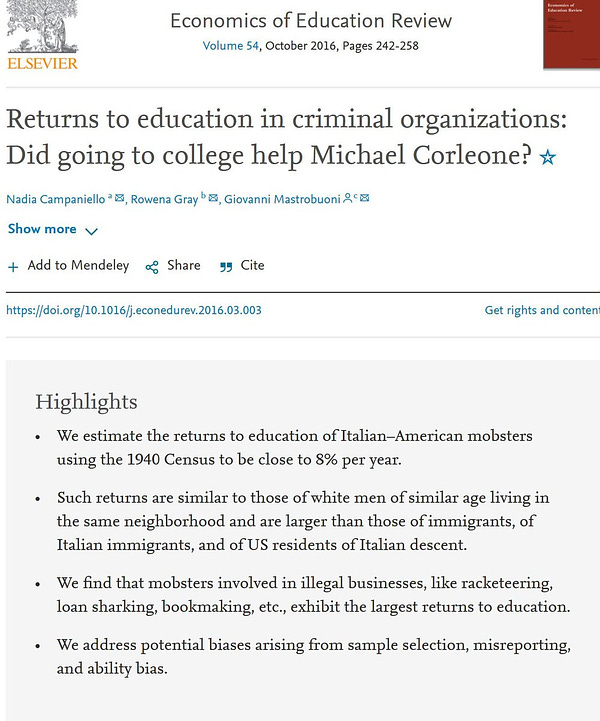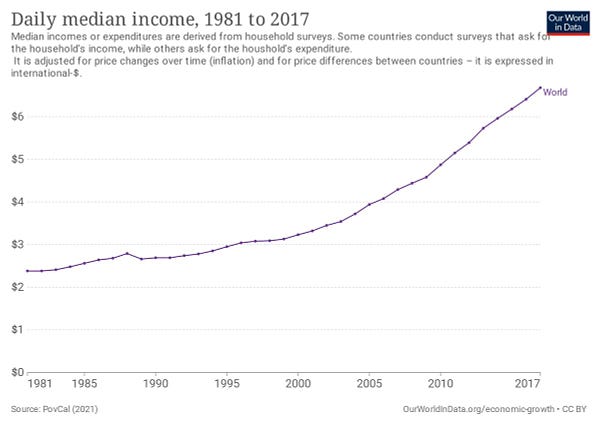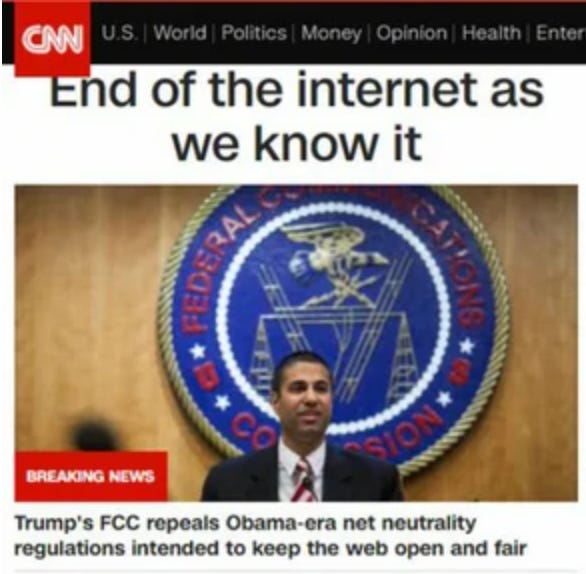Links For February
[Remember, I haven’t independently verified each link. On average, commenters will end up spotting evidence that around two or three of the links in each links post are wrong or misleading. I correct these as I see them, and will highlight important corrections later, but I can’t guarantee I will have caught them all by the time you read this.]
1:The newest studies don’t find evidence that extracurriculars like chess, second languages, playing an instrument, etc can improve in-school learning.
2: Did you know: Spanish people consider it good luck to eat twelve grapes at midnight on New Years, one at each chime of the clock tower in Madrid. This has caused enough choking deaths that doctors started a petition to make the clock tower chime more slowly.
3: At long last, scientists have discovered a millipede that really does have (more than) a thousand legs, Eumillipes persephone , which lives tens of meters underground in Australia and in your nightmares. Recent progress in this area inspired me to Fermi-estimate a millipede version of Moore’s Law, which suggests we should be up to megapedes by 2140 and gigapedes by 2300.
4: euphoric-baseball-61 on the subreddit challenges the claim that the brain doesn’t reach maturity until age 25.
5: Great powers traditionally have proxy wars with each other by arming/advising their preferred faction of smaller conflicts in weaker countries. This is a naturally limited strategy, because the faction still has to have enough soldiers to use the weapons and advice efficiently. So what happens to proxy wars once great powers develop fully autonomous weapons?
6: Tarot of the Silicon Dawn (draw random card)
7:
 priya @PrigooseCorridors were invented in 1597 Everything around you was once a concept in a human’s imagination
priya @PrigooseCorridors were invented in 1597 Everything around you was once a concept in a human’s imagination  [3:44 PM ∙ Jun 16, 2019
[3:44 PM ∙ Jun 16, 2019
2,111Likes564Retweets](https://twitter.com/Prigoose/status/1140284067054624778)
8: Economist: Why Brahmins Lead Western Firms But Rarely Indian Ones. Brahmins are the highest Indian caste; in India they tend to be academics/lawyers/etc, but in the US they are disproportionately likely to become CEOs (including the current leaders of Google and Microsoft). Article theorizes that this is a combination of more business-related Indian castes having better networking within India (so motivated Brahmins tend to go abroad), Brahmins being good at the traditional academic pathway that lends itself well to immigration, plus maybe affirmative action against them in India. Here’s a rebuttal I link to out of duty, but I’m not sure it’s worth wading through the woke outrage to get to the two or three mildly interesting facts (Brahmins started immigrating before India’s affirmative action really ramped up, and they might have a first-mover advantage from building immigrant communities earlier).
9: Most previous studies of preschool found zero to negative effects on academic achievement, but potentially positive effects on nonacademic outcomes like discipline and grit. A big new study of lower-income children (h/t Samuel Hammond) confirms negative effects on academic achievement but also finds negative effects on non-academic outcomes. I have yet to look at it closely enough to have a good theory of what’s going on here, or whether parents should be trying to keep their kids out of preschool.
10:Consensus is an app (currently in beta) that claims that they can automate searching through and analyzing the scientific literature using natural language processing. In my conversation with them, I pointed out the skulls of all the previous people who tried that, littering their path, and they remained upbeat and said their product was definitely going to be the one that works. I tried it with some medium-subtlety questions, and got lots of papers using keywords I used in the questions but nothing I would really call an answer - but they remained upbeat and said their product was definitely going to be the one that works. Anyway, you can sign up for their beta here.
11:
 Richard Ngo @RichardMCNgoI’ve spent a long time developing this curriculum; I think it’s now the best resource for learning about AGI safety, even if you’re not taking the course. So if you’ve heard the ideas but never dug into details, reading it through is a good place to start!
Richard Ngo @RichardMCNgoI’ve spent a long time developing this curriculum; I think it’s now the best resource for learning about AGI safety, even if you’re not taking the course. So if you’ve heard the ideas but never dug into details, reading it through is a good place to start!  docs.google.com2022 AGI Safety Fundamentals alignment curriculumThis is the most up-to-date version of the AGI Safety Fundamentals alignment curriculum, as of the end of January 2022, and the version that will be used for the January-March 2022 cohort. (All substantive changes are copied over to the version on the EA Cambridge website.) Overview The course co…[5:00 PM ∙ Feb 12, 2022
docs.google.com2022 AGI Safety Fundamentals alignment curriculumThis is the most up-to-date version of the AGI Safety Fundamentals alignment curriculum, as of the end of January 2022, and the version that will be used for the January-March 2022 cohort. (All substantive changes are copied over to the version on the EA Cambridge website.) Overview The course co…[5:00 PM ∙ Feb 12, 2022
346Likes60Retweets](https://twitter.com/RichardMCNgo/status/1492544228680888320)
[edited to add: also an AI Governance curriculum here]
12:The Dangers Of Low-Pay, High-Status Jobs. A good article in many ways, but the part I appreciate most was taking “why are so many journalists live in Brooklyn?” (which I had always thought of as a kind of a running gag, or dig on the journalistic monoculture) and doing economic analysis to it, of the same form of “why are so many tech companies in the Bay Area?” or “why are so many entertainment studios in LA?”
13: Creepy thing of the month (h/t Neural Net Guesses Memes):
14: You’ve probably heard statistics about how 50% of transgender youth attempt suicide before age 21. This paper tries to analyze the situation in more depth. The 50% number usually comes from surveys, but there’s some evidence people exaggerate on surveys, rounding up “I think about it a lot” to “I attempted”. The authors gather data on completed suicides among trans people, and find that they’re about 0.01%/year (which is about 5x the cisgender rate). If we suppose that people have about 5 years between becoming transgender and turning 21, then the 50% attempted suicide rate → 0.05% completed suicide rate implies that 1/1000th of the youth who report attempting suicide on surveys complete suicide - which sounds about right to me [but see this comment for a critique]
15: Gwern on the failures of 20th century eugenics. I’ve previously linked a piece about how, aside from the general moral failure, the 20th century eugenicists got lots of implementation details really wrong. Gwern adds to the picture: they had a purely Mendelian (as opposed to polygenic) model of intelligence, and felt that bad traits were probably caused by single recessive genes. This dichotomized the population in a way that contributed to the moral problems - if IQ is truly a continuum, then someone with 120 IQ might still wonder if they were “inferior” to someone with 130 IQ, in a way that made them feel some sympathy to someone with 80 IQ who was being pronounced “inferior” by the eugenicists of the time. But instead, they thought some people had the specific recessive “low intelligence” gene, those people could be “cleansed” from the population, and then everyone else would be fine! It also prevented them from considering improving the populace by encouraging intelligent people to breed more (as opposed to sterilizing unintelligent people) - this wouldn’t eliminate the recessive variants that were causing all the trouble! I’m confused how they could have believed this even with the limited knowledge of the time; this was long after Galton had proven that genius was genetic, and once you have genetic genius you know there’s more going on than Mendelian inheritance of subnormality.
16: Sexual selection bridges peaks in adaptive fitness landscapes
17:NFTorah: “The Torah [is] the original blockchain”. I think it’s funny that this exists, but it’s exactly what you would expect, and you don’t have to click on the link.
18: More IRB nightmares.
19:
678Likes77Retweets](https://twitter.com/cblatts/status/1483514901888913417)
20:DeepMind made a programming AI that was able to participate in a human coding competition and place around the middle. Nostalgebraist gives his thoughts: “impressed with the raw performance, not massively surprised, not sold that it implies anything big in particular”. A lot of people will be watching whether it can win programming competitions outright a year or two from now, though I bet their perspectives on how relevant this is for AI takeoff speeds will be pretty mixed.
21:Effective altruist organizations as Zendaya outfits.
22:Brain Efficiency: Much More Than You Wanted To Know. “Why should we care? Brain efficiency matters a great deal for AGI timelines and takeoff speeds, as AGI is implicitly/explicitly defined in terms of brain parity.”
23: I’m not going throw out my copy of The Case Against Education just yet - I haven’t checked this study but I bet there are lots of possible confounders. Still, this would be fun for somebody more interested to analyze in depth:
3,665Likes884Retweets](https://twitter.com/emollick/status/1477713880767995911)
24: Best of Scott Sumner archives: There’s Only One Sensible Way To Measure Economic Inequality. “You cannot put the burden of a tax on someone unless you cut into his or her consumption. If … tax increases did not cause Gates and Buffett to tighten their belts, then they paid precisely 0% of that tax increase. Someone else paid, even if they wrote the check. If they invested less due to the tax, then workers might have received lower wages. If they gave less to charity then very poor Africans paid the tax.”
25: The latest in the Greater Male Variability Hypothesis: Harrison, Noble, and Jennions publish a meta-analysis failing to find evidence of greater male variability in the personality of non-human animals. Del Giudice and Gangestad have a rebuttal saying that they were underpowered to detect it even if it did exist, plus noting the ways that media coverage of this study was incredibly irresponsible even by its own terms.
26: Some recent critiques of Cook (2014) on racial violence vs. black patents, including Michael Wiebe challenging the violence measures and AnechoicMedia arguing that the black patent measure declines right when switching from one (more complete) dataset to another (less complete) one. Rebuttal by Brad DeLong here, he argues that Cook uses multiple methods and some of them don’t have this problem. Relevant since Cook is now being considered for the Federal Reserve; see eg this Wall Street Journal editorial against.
27: Claim: 31% of British people say they have seen or met Queen Elizabeth (this seems plausible to me, I would answer ‘yes’ to this because she visited Ireland when I lived there, I watched the parade in her honor, and I could vaguely glimpse her on the inside of her car).
28: This couple-of-month-period in wokeness:
-
Scientific American attacks late biologist EO Wilson, in a screed whose highlight is calling him problematic for describing ants as having “colonies”. This is part of a more general (and surprisingly fast) pivot at Scientific American from real science to culture warring; when even Eric Turkheimer thinks you’ve gotten too woke, you’ve gotten too woke.
-
Unherd on the rise of sensitivity readers, ie censors who publishing companies employ to remove problematic material from books.
-
New York Times takes over popular word game Wordle; its first act is to remove potentially offensive words - like “slave” - from the word list.
29: Russian nationalist blogger Anatoly Karlin on why Putin wants to invade Ukraine. Short version: partly emotional nationalism, but partly rational calculation that as Russia tries to leave the Western way of life and go it alone in some kind of cultural/economic sense, it will have better odds of self-sufficiency with an extra 35 million people in its sphere of influence. Related, and excellent: how Russia thought about the recent protests in Kazakhstan.
30: Wikipedia says that the 1960 Valdivia, Chile earthquake:
…released almost a quarter of the total seismic energy released by all earthquakes in the 20th century.
31: Mr. Global, a sort of male version of the Miss Universe pageant, had a “wear your country’s traditional dress” contest in 2019, with pretty great results:
More at the link.
32: Related, from Works In Progress: no, it’s not just that only the prettiest buildings of past ages survived, past ages really did produce (on average) prettier buildings.
33:Sovereign-citizen-like movements around the US and the world. Every commentary you’ll read on sovereign citizens focuses on how the only possible explanation for the movement is (white) racism. I think pieces like this show a more subtle story. Yes, white nationalist groups are heavily involved in sovereign citizenry. But so are black nationalist groups, Native Hawaiian secessionist groups, Australian Aboriginal independence movements, etc, etc, etc. It seems like a powerful attractor for anyone who’s angry or feels mistreated for any reason.
34: Did you know: the appendices of 1984 strongly suggest that in the canonical timeline, the Oceanian dictatorship fell a few years after the events of the book and was replaced by a more liberal state.
35: New study: Epstein-Barr virus probably causes multiple sclerosis. Greg Cochran was saying this twenty years ago, which is impressive; the usual Cochran → everyone else gap is more like 10-15.
36: An interesting recent spat between BMJ and Facebook: BMJ, one of the most prestigious medical journals in the world) published some article about poor clinical research practices at a vaccine company. Some anti-vaxxers shared it on Facebook, and Facebook responded by adding their “missing context” tag to the BMJ article. This made the BMJ angry (well, this plus Facebook’s explanation which called the BMJ a “news blog”), so the editors wrote an Open Letter From The BMJ To Mark Zuckerberg, saying “actually, we are one of the most powerful medical establishment institutions in the world, you can’t do this to us”. The fact checker who Facebook subcontracts their censorship decisions to, Lead Stories, then wrote a surprisingly thoughtful response saying: they thought the BMJ article lacked important context, that was all they told Facebook, and they stand by their decision even after learning that the BMJ is much more prestigious and important than they thought. I’m having trouble figuring out what emotions to have here: on the one hand I hate censorship, but on the other hand seeing the BMJ seething at their inability to pull rank is oddly satisfying. Also, this same thing apparently happened around the same time with Instagram and the Cochrane Collaboration.
37:
1,945Likes415Retweets](https://twitter.com/emollick/status/1479679442662346753)
38: Emil Kierkegaard on the flimsy evidence for exercise as a depression treatment.
39:
1,339Likes457Retweets](https://twitter.com/DinaPomeranz/status/1457278202020237313)
Interested in hearing more about this: was the 2000 - 2017 period really better than previous periods? If so, why? Is it just China, or something else?
40:Harold Lee on The Post COVID World, making a point I hadn’t seen anywhere else before:
Risk-averse institutions will lag behind individuals in taking the risk to meet in person, and they will gradually lose importance as centers for social life. A network of friends of friends, however, will be more resilient. New friends will increasingly come from introductions from other friends you’ve already made, rather than meeting people through contra dancing or church. Civil society institutions will generally lose influence as their traditional methods of outreach and group bonding, although some may adapt by developing more models such as small groups with a cell structure, which approximate the flexibility of a group of friends who can adapt meeting practices as they please, at protective arm’s length from the greater organization’s brand. Regardless, the social landscape of 2030 will likely be more illegible than that of 2019, with formal organizations less important and groups of friends and collaborators taking on more importance.
(I will say that big institutions have been less risk-averse than I worried - I hear Google stopped requiring masks in the Bay Area today, and Polymarket says 79% chance of no mask mandate on domestic flights by November - so maybe this won’t come to pass after all)
41: Headline from four years ago (h/t Nathan Learner)
I wonder how a prediction market at the time would have priced the claim “five years from now, a majority of people will agree that the Internet as they knew it ended in 2017 with the repeal of net neutrality”. Also - in the process of confirming that this headline was real (it was) I found this Forbes article claiming the end of the Internet as we know it in 2012 (I think it was about 10% of the way to being right, insofar as some news sources do have paywalls now), and this Wired article warning that a 2014 case on Net Neutrality “could lead to fracturing of the singular internet into a multiplicity of sub-nets and to an all-out negotiation battlefield with global ramifications”.
42: This sounds like the sort of catchy/exciting idea that would become an urban legend whether it was true or not, but Elizabeth says it’s true: putting your phone in grayscale makes it less addictive.
43: Alwaysrinse on Judaism on genetic engineering:
Judaism is lenient on genetic engineering as “Jewish tradition posits that man was created in the ‘image of G-d’ to be a partner with G-d in mastering and perfecting himself and the natural world” and Judaism has a “general principle that anything not explicitly prohibited in the Bible and Talmud is assumed to be permitted.” Rabbi Dr. Avraham Steinberg, the co-chair of Israel’s National Bioethics Council, writes, “As long as the act of perfecting the world does not violate halakhic prohibitions, or lead to results which would be halakhically prohibited, then we are given a mandate to use science and technology to improve the world.” Genetic engineering of course is not halakhically prohibited. He “believes that we should proceed with … genetic engineering [even if it is non-life-preserving] as long as we believe that the benefits to man outweigh the risks.”
44:
9,946Likes3,012Retweets](https://twitter.com/DanielSolis/status/1487913576929103884)
Many many more at the thread here.

 Chris Blattman @cblatts@ethanbdm When we piloted a public lottery to evaluate cash transfers in Liberia, the potential recipients arranged beforehand to insure one another. After the randomization and grant, the winners compensated the losers and unraveled the field experiment.
Chris Blattman @cblatts@ethanbdm When we piloted a public lottery to evaluate cash transfers in Liberia, the potential recipients arranged beforehand to insure one another. After the randomization and grant, the winners compensated the losers and unraveled the field experiment. Ethan Mollick @emollickA cool study that is able to show the benefit of college beyond being a signal to employers - Mafia members who go to college become more effective criminals. Police records show, Mafiosos who went to college earned 8% more per year, even higher for those running complex crimes.
Ethan Mollick @emollickA cool study that is able to show the benefit of college beyond being a signal to employers - Mafia members who go to college become more effective criminals. Police records show, Mafiosos who went to college earned 8% more per year, even higher for those running complex crimes. 







 Dina D. Pomeranz @DinaPomeranzTwo facts many people don’t know: 1) The global median income has doubled in 17 years from 2000 to 2017. A stunningly rapid progress the world has never seen before. (Adjusted for prices, so not due to inflation) 2) Still half the people in the world have less than $7 per day
Dina D. Pomeranz @DinaPomeranzTwo facts many people don’t know: 1) The global median income has doubled in 17 years from 2000 to 2017. A stunningly rapid progress the world has never seen before. (Adjusted for prices, so not due to inflation) 2) Still half the people in the world have less than $7 per day 

 Daniel Solis, birds suddenly appear @DanielSolisThese Birds Do Not Exist I trained an AI on public domain bird illustrations from old books. Ornithologists and birders, I’d LOVE it if you were able to still ID some of these weirdos. I’ll share some of the “normal” results first, the ones that kinda sorta look like real birds.
Daniel Solis, birds suddenly appear @DanielSolisThese Birds Do Not Exist I trained an AI on public domain bird illustrations from old books. Ornithologists and birders, I’d LOVE it if you were able to still ID some of these weirdos. I’ll share some of the “normal” results first, the ones that kinda sorta look like real birds. 


